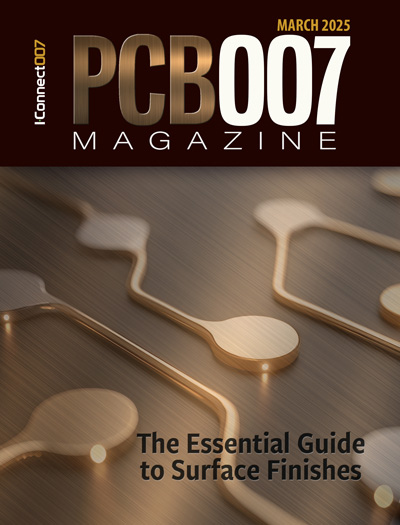-

- News
- Books
Featured Books
- pcb007 Magazine
Latest Issues
Current Issue
In Pursuit of Perfection: Defect Reduction
For bare PCB board fabrication, defect reduction is a critical aspect of a company's bottom line profitability. In this issue, we examine how imaging, etching, and plating processes can provide information and insight into reducing defects and increasing yields.

Voices of the Industry
We take the pulse of the PCB industry by sharing insights from leading fabricators and suppliers in this month's issue. We've gathered their thoughts on the new U.S. administration, spending, the war in Ukraine, and their most pressing needs. It’s an eye-opening and enlightening look behind the curtain.

The Essential Guide to Surface Finishes
We go back to basics this month with a recount of a little history, and look forward to addressing the many challenges that high density, high frequency, adhesion, SI, and corrosion concerns for harsh environments bring to the fore. We compare and contrast surface finishes by type and application, take a hard look at the many iterations of gold plating, and address palladium as a surface finish.
- Articles
- Columns
Search Console
- Links
- Media kit
||| MENU - pcb007 Magazine
Electroplated Copper Filling of Through-holes: Influence on Hole Geometry
February 7, 2017 | Ron Blake, Andy Oh, et al.Estimated reading time: 1 minute
Abstract
This paper discusses a through-hole copper filling process for application in high-density interconnect constructions on thin IC and LED substrates where high reliability and thermal management are essential. The process consists of a two-step acid copper plating cycle. The first step utilizes periodic pulse reverse (PPR) electroplating to form a conductive copper bridge across the middle of a through-hole and is followed by direct current electroplating to fill the resultant vias formed in the bridge cycle.
The ability of the process to fill a variety of through-hole sizes on substrates of varying thickness while minimizing the overall surface copper build-up are critical in applications requiring efficient thermal management as circuit miniaturization continues.
The through-hole fill technology and factors that affect its performance such as substrate thickness and through-hole diameter will be presented in this paper.
Introduction
Resin or paste plugging of through-holes in cores has been a part of build-up technology, especially in IC substrate construction, for many years. Technological advances encompassing increased circuit density and stacked via construction, coupled with higher power devices, have added an extra dimension of thermal management where a copper filled through-hole becomes advantageous (Figure 1).
Advantages of copper filled through-holes include:
- Reduction in CTE mismatch of resin/paste plug
- Stable platform for stacking microvias
- Solid pillar structure within through-hole
- Lower likelihood of adhesion failure on the plated-over filled via
- High thermal conductivity of copper
New technologies were developed to completely fill through-holes and vias in build-up core layers in HDI and IC substrates with solid copper. Among the approaches for filling through-holes in a thin core board with copper was DC plating.
To read this article which appeared in the January 2017 issue of The PCB Magazine, click here.
Suggested Items
RF PCB Design Tips and Tricks
05/08/2025 | Cherie Litson, EPTAC MIT CID/CID+There are many great books, videos, and information online about designing PCBs for RF circuits. A few of my favorite RF sources are Hans Rosenberg, Stephen Chavez, and Rick Hartley, but there are many more. These PCB design engineers have a very good perspective on what it takes to take an RF design from schematic concept to PCB layout.
Trouble in Your Tank: Causes of Plating Voids, Pre-electroless Copper
05/09/2025 | Michael Carano -- Column: Trouble in Your TankIn the business of printed circuit fabrication, yield-reducing and costly defects can easily catch even the most seasoned engineers and production personnel off guard. In this month’s column, I’ll investigate copper plating voids with their genesis in the pre-plating process steps.
Elephantech: For a Greener Tomorrow
04/16/2025 | Marcy LaRont, PCB007 MagazineNobuhiko Okamoto is the global sales and marketing manager for Elephantech Inc., a Japanese startup with a vision to make electronics more sustainable. The company is developing a metal inkjet technology that can print directly on the substrate and then give it a copper thickness by plating. In this interview, he discusses this novel technology's environmental advantages, as well as its potential benefits for the PCB manufacturing and semiconductor packaging segments.
Trouble in Your Tank: Organic Addition Agents in Electrolytic Copper Plating
04/15/2025 | Michael Carano -- Column: Trouble in Your TankThere are numerous factors at play in the science of electroplating or, as most often called, electrolytic plating. One critical element is the use of organic addition agents and their role in copper plating. The function and use of these chemical compounds will be explored in more detail.
IDTechEx Highlights Recyclable Materials for PCBs
04/10/2025 | IDTechExConventional printed circuit board (PCB) manufacturing is wasteful, harmful to the environment and energy intensive. This can be mitigated by the implementation of new recyclable materials and technologies, which have the potential to revolutionize electronics manufacturing.


